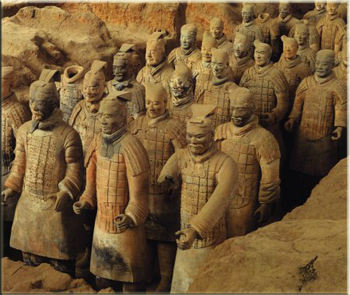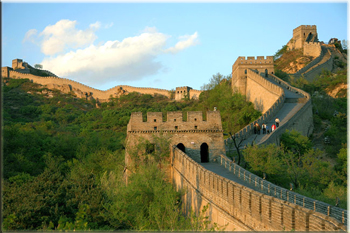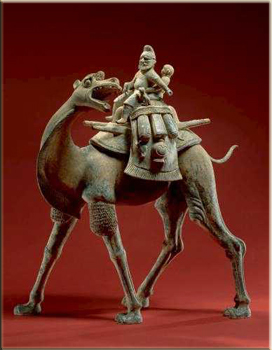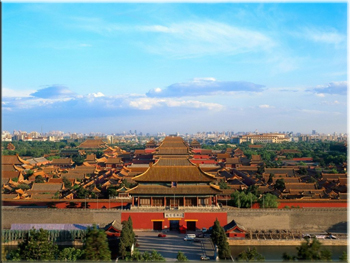History of Ancient China
Chinese civilization originated in various city-states along the Yellow River valley in the Neolithic era. The origins of Chinese culture, literature and philosophy developed during the Zhou Dynasty (1122 BC to 256 BC). It was the longest lasting dynasty and spans the period in which the written script evolved from ancient oracle script to the beginnings of modern Chinese writing.
The conventional view of Chinese history is that of a country alternating between periods of political unity and disunity and occasionally becoming dominated by foreign peoples, most of whom were assimilated into the Han Chinese population. Cultural and political influences from many parts of Asia, carried by successive waves of immigration, expansion, and assimilation, merged to create modern Chinese culture.
Zhou Dynasty – Ancient History of China
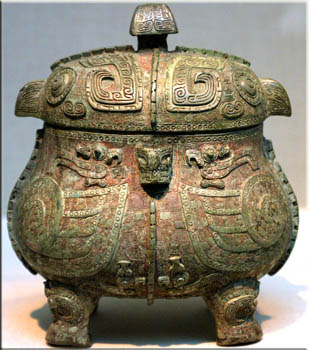 Photo to the right: A bronze vassal from the Zhou Dynasty
Photo to the right: A bronze vassal from the Zhou Dynasty
The Zhou Dynasty was the longest dynasty in Chinese history, from 1027 to approximately 221 B.C. By the end of the 2nd millennium BC, the Zhou Dynasty began to emerge in the Yellow River valley, overrunning the Shang.
The Zhou appeared to have begun their rule under a semi-feudal system. The Zhou were a people who lived west of Shang, and the Zhou leader had been appointed “Western Protector” by the Shang. The ruler of the Zhou, King Wu, with the assistance of his brother, the Duke of Zhou, as regent managed to defeat the Shang at the Battle of Muye.
The king of Zhou at this time invoked the concept of the Mandate of Heaven to legitimize his rule, a concept that would be influential for almost every successive dynasty.
The Zhou initially moved their capital west to an area near modern Xi’an, near the Yellow River, but they would preside over a series of expansions into the Yangtze River valley. This would be the first of many population migrations from north to south in Chinese history.
Spring and Autumn Period – China Ancient History
In the 8th century BC, power became decentralized during the Spring and Autumn Period , named after the influential Spring and Autumn Annals. In this period, local military leaders used by the Zhou began to assert their power and vie for hegemony. The situation was aggravated by the invasion of other peoples from the northwest, such as the Qin, forcing the Zhou to move their capital east to Luoyang. This marks the second large phase of the Zhou dynasty: the Eastern Zhou.
In each of the hundreds of states that eventually arose, local strongmen held most of the political power and continued their subservience to the Zhou kings in name only. Local leaders for instance started using royal titles for themselves.
The Hundred Schools of Thought of Chinese philosophy blossomed during this period, and such influential intellectual movements as Confucianism, Taoism, Legalism and Mohism were founded, partly in response to the changing political world. The Spring and Autumn Period is marked by a falling apart of the central Zhou power. China now consists of hundreds of states, some only as large as a village with a fort.
Warring States Period – Ancient History in China
After further political consolidation, seven prominent states remained by the end of 5th century BC, and the years in which these few states battled each other are known as the Warring States Period.
Though there remained a nominal Zhou king until 256 BC, he was largely a figurehead and held little real power. As neighboring territories of these warring states, including areas of modern Sichuan and Liaoning, were annexed, they were governed under the new local administrative system of commandeering and prefecture.
This system had been in use since the Spring and Autumn Period and parts can still be seen in the modern system of Sheng & Xian (province and county. The final expansion in this period began during the reign of Ying Zheng, the king of Qin. His unification of the other six powers, and further annexations in the modern regions of Zhejiang, Fujian, Guangdong and Guangxi in 214 BC enabled him to proclaim himself the First Emperor Qin Shi Huangdi.
Qin Dynasty
Historians often refer to the period from Qin Dynasty to the end of Qing Dynasty as Imperial China.
Though the unified reign of the Qin Emperor lasted only 12 years, he managed to subdue great parts of what constitutes the core of the Han Chinese homeland and to unite them under a tightly centralized Legalist government seated at Xianyang (close to modern Xi’an).
The doctrine of legalism that guided the Qin emphasized strict adherence to a legal code and the absolute power of the emperor. This philosophy of Legalism, while effective for expanding the empire in a military fashion, proved unworkable for governing it in peace time.
The Qin presided over the brutal silencing of political opposition, including the event known as the burning and burying of scholars. This would be the impetus behind the later Han Synthesis incorporating the more moderate schools of political governance.
The Qin Dynasty is well known for beginning the Great Wall of China, which was later augmented and enhanced during the Ming Dynasty.
The other major contributions of the Qin include the concept of a centralized government, the unification of the legal code, written language, measurement, and currency of China after the tribulations of the Spring and Autumn and Warring States Periods. Even something as basic as the length of axles for carts had to be made uniform to ensure a viable trading system throughout the empire.
Han Dynasty – China Ancient History
The Han Dynasty (202 BC – 220 AD) emerged in 206 BC, with its founder Liu Bang proclaimed emperor in 202. It was the first dynasty to embrace the philosophy of Confucianism, which became the ideological underpinning of all regimes until the end of imperial China. Under the Han Dynasty, China made great advances in many areas of the arts and sciences.
Emperor Wu consolidated and extended the Chinese empire by pushing back the Xiongnu (sometimes identified with the Huns) into the steppes of modern Inner Mongolia, wresting from them the modern areas of Gansu, Ningxia and Qinghai.
This enabled the first opening of trading connections between China and the West, the Silk Road. Han Dynasty general Ban Chao expanded his conquests across the Pamirs to the shores of the Caspian Sea.[18] The first of several Roman embassies to China is recorded in Chinese sources, coming from the sea route in 166, and a second one in 284.
Nevertheless, land acquisitions by elite families gradually drained the tax base. In AD 9, the usurper Wang Mang founded the short-lived Xin (“New”) Dynasty and started an extensive program of land and other economic reforms. These programs, however, were never supported by the land-holding families, for they favored the peasants. The instability brought about chaos and uprisings.
Emperor Guangwu reinstated the Han Dynasty with the support of land-holding and merchant families at Luoyang, east of Xi’an. This new era would be termed the Eastern Han Dynasty. Han power declined again amidst land acquisitions, invasions, and feuding between consort clans and eunuchs.
The Yellow Turban Rebellion broke out in 184, ushering in an era of warlords. In the ensuing turmoil, three states tried to gain predominance in the Period of the Three Kingdoms. This time period has been greatly romanticized in works such as Romance of the Three Kingdoms.
Jin Period – China Ancient History
Though the three kingdoms were reunited temporarily in 278 by the Jin Dynasty, the contemporary non-Han Chinese ethnic groups controlled much of the country in the early 4th century and provoked large-scale Han Chinese migrations to south of the Chang Jiang.
In 303 the Di people rebelled and later captured Chengdu, establishing the state of Cheng Han. Under Liu Yuan the Xiongnu rebelled near today’s Linfen County and established the state of Han Zhao. His successor Liu Cong captured and executed the last two Western Jin emperors.
Sixteen kingdoms were a plethora of short-lived non-Chinese dynasties that came to rule the whole or parts of northern China in the 4th and 5th centuries. Many ethnic groups were involved, including ancestors of the Turks, Mongolians, and Tibetans.
Most of these nomadic peoples had to some extent been “Sinicized” long before their ascent to power. In fact, some of them, notably the Ch’iang and the Xiong-nu, had already been allowed to live in the frontier regions within the Great Wall since late Han times.
Southern and Northern Dynasties – China Ancient History
Signaled by the collapse of East Jin Dynasty in 420, China entered the era of the Southern and Northern Dynasties. The Han people managed to survive the military attacks from the nomadic tribes of the north, such as the Xian Bei and their civilization continued to thrive.
In Southern China, fierce debates about whether Buddhism should be allowed to exist were held frequently by the royal court and nobles. Finally, near the end of the Southern and Northern Dynasties era, both Buddhist and Taoist followers compromised and became more tolerant of each other.
In 589, Sui annexed the last Southern Dynasty, Chen, through military force, and put an end to the era of Southern and Northern Dynasties.
Sui Dynasty – Ancient History of China
The Sui Dynasty, which managed to reunite the country in 589 after nearly four centuries of political fragmentation, played a role more important than its length of existence would suggest. The Sui brought China together again and set up many institutions that were to be adopted by their successors, the Tang.
Like the Qin, however, the Sui overused their resources and collapsed. Also similar to the Qin, traditional history has judged the Sui somewhat unfairly, as it has stressed the harshness of the Sui regime and the arrogance of its second emperor, giving little credit for the Dynasty’s many positive achievements.
Tang Dynasty – Ancient History of China
On June 18, 618, Gaozu took the throne, and the Tang Dynasty was established, opening a new age of prosperity and innovations in arts and technology. Buddhism, which had gradually been established in China from the first century, became the predominant religion and was adopted by the imperial family and many of the common people.
Chang’an (modern Xi’an) is thought to have been the world’s largest city at the time. The Tang, like the Han, kept the trade routes open to the west and south and there was extensive trade with distant foreign countries and many foreign merchants settled in China.
The Tang introduced a new system into the Chinese government, called the “Equal Field System”. This system gave families land grants from the Emperor based on their needs, not their wealth.
From about 860 the Tang Dynasty began to decline due to a series of rebellions within China itself, and in the previously subject Kingdom of Nanzhao to the south. One of the warlords, Huang Chao, captured Guangzhou in 879, killing most of the 200,000 inhabitants including most of the large colony of foreign merchant families there.
In late 880 Luoyang surrendered to him and on 5 January, 881 he conquered Chang’an. The emperor Xizong fled to Chengdu and Huang established a new temporary regime, which was eventually destroyed by Tang forces, but another time of political chaos followed.
Song Dynasty and Liao, Jin, Western Xia
In 960, the Song Dynasty (960-1279) gained power over most of China and established its capital in Kaifeng starting a period of economic prosperity, while the Khitan Liao Dynasty ruled over Manchuria, present-day Mongolia, and parts of Northern China.
In 1115 the Jurchen Jin Dynasty (1115-1234) emerged to prominence, annihilating the Liao Dynasty in 10 years. Meanwhile, in what are now the northwestern Chinese provinces of Gansu, Shaanxi, and Ningxia, there emerged a Western Xia Dynasty from 1032 up to 1227, established by Tangut tribes.
It also took power over northern China and Kaifeng from the Song Dynasty, which moved its capital to Hangzhou. The Southern Song Dynasty also suffered the humiliation of having to acknowledge the Jin Dynasty as formal overlords. In the ensuing years China was divided between the Song Dynasty, the Jin Dynasty and the Tangut Western Xia. Southern Song experienced a period of great technological development which can be explained in part by the military pressure that it felt from the north.
This included the use of gunpowder weapons, which played a large role in the Song Dynasty naval victories against the Jin in the Battle of Tangdao and Battle of Caishi on the Yangtze River in 1161. Furthermore, China’s first permanent standing navy was assembled and provided an admiral’s office at Dinghai in 1132, under the reign of Emperor Renzong of Song.
The Song Dynasty is considered by many to be classical China’s high point in science and technology, with innovative scholar-officials such as Su Song (1020-1101) and Shen Kuo (1031-1095). There was court intrigue with the political rivals of the Reformers and Conservatives, led by the chancellors Wang Anshi and Sima Guang, respectively.
By the mid to late 13th century the Chinese had adopted the dogma of Neo-Confucian philosophy formulated by Zhu Xi. There were enormous literary works compiled during the Song Dynasty, such as the historical work of the Zizhi Tongjian. Culture and the arts flourished, with grandiose artworks such as Along the River During Qingming Festival and Eighteen Songs of a Nomad Flute, while there were great Buddhist painters such as Lin Tinggui.
Yuan Dynasty
Jurchen tribes’ Jin Dynasty, whose names are also rendered “Jin” in pinyin, was defeated by the Mongols, who then proceeded to defeat the Southern Song in a long and bloody war, the first war where firearms played an important role. During the era after the war, later called the Pax Mongolica, adventurous Westerners such as Marco Polo traveled all the way to China and brought the first reports of its wonders to Europe. In the Yuan Dynasty, the Mongols were divided between those who wanted to remain based in the steppes and those who wished to adopt the customs of the Chinese.
Kublai Khan, grandson of Genghis Khan, wanting to adopt the customs of China, established the Yuan Dynasty. This was the first dynasty to rule the whole of China from Beijing as the capital. Beijing had been ceded to Liao in AD 938 with the Sixteen Prefectures of Yan Yun. Before that, it had been the capital of the Jin, who did not rule all of China.
Before the Mongol invasion, Chinese dynasties reportedly had approximately 120 million inhabitants; after the conquest was completed in 1279, the 1300 census reported roughly 60 million people. The 14th century epidemics of plague (Black Death) is estimated to have killed 30% of the population of China.
Ming Dynasty
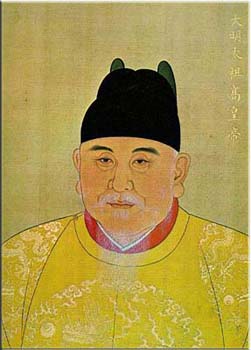
Throughout the Yuan Dynasty, which lasted less than a century, there was relatively strong sentiment among the populace against the Mongol rule. The frequent natural disasters since the 1340s finally led to peasant revolts. The Yuan Dynasty was eventually overthrown by the Ming Dynasty in 1368.
Urbanization increased as the population grew and as the division of labor grew more complex. Large urban centers, such as Nanjing and Beijing, also contributed to the growth of private industry.
In particular, small-scale industries grew up, often specializing in paper, silk, cotton, and porcelain goods. For the most part, however, relatively small urban centers with markets proliferated around the country. Town markets mainly traded food, with some necessary manufactures such as pins or oil.
Despite the xenophobia and intellectual introspection characteristic of the increasingly popular new school of neo-Confucianism, China under the early Ming Dynasty was not isolated.
Foreign trade and other contacts with the outside world, particularly Japan, increased considerably. Chinese merchants explored all of the Indian Ocean, reaching East Africa with the voyages of Zheng He, original name Ma Sanbao.
Zhu Yuanzhang, the founder of the dynasty, laid the foundations for a state interested less in commerce and more in extracting revenues from the agricultural sector. Perhaps because of the Emperor’s background as a peasant, the Ming economic system emphasized agriculture, unlike that of the Song and the Mongolian Dynasties, which relied on traders and merchants for revenue.
Neo-feudal landholdings of the Song and Mongol periods were expropriated by the Ming rulers. Land estates were confiscated by the government, fragmented, and rented out. Private slavery was forbidden. Consequently, after the death of Emperor Yong-le, independent peasant landholders predominated in Chinese agriculture. These laws might have paved the way to removing the worst of the poverty during the previous regimes.
The dynasty had a strong and complex central government that unified and controlled the empire. The emperor’s role became more autocratic, although Zhu Yuanzhang necessarily continued to use what he called the “Grand Secretaries” to assist with the immense paperwork of the bureaucracy, including memorials (petitions and recommendations to the throne), imperial edicts in reply, reports of various kinds, and tax records.
It was this same bureaucracy that later prevented the Ming government from being able to adapt to changes in society, and eventually led to its decline.
Emperor Yong-le strenuously tried to extend China’s influence beyond its borders by demanding other rulers send ambassadors to China to present tribute. A large navy was built, including four-masted ships displacing 1,500 tons. A standing army of 1 million troops (some estimate as many as 1.9 million) was created.
The Chinese armies conquered Vietnam for around 20 years, while the Chinese fleet sailed the China seas and the Indian Ocean, cruising as far as the east coast of Africa. The Chinese gained influence in Eastern Turkestan. Several maritime Asian nations sent envoys with tribute for the Chinese emperor.
Domestically, the Grand Canal was expanded, and proved to be a stimulus to domestic trade. Over 100,000 tons of iron per year were produced. Many books were printed using movable type. The imperial palace in Beijing’s Forbidden City reached its current splendor. It was also during these centuries that the potential of south China came to be fully exploited. New crops were widely cultivated and industries such as those producing porcelain and textiles flourished.
In 1449 Esen Tayisi led an Oirat Mongol invasion of northern China which culminated in the capture of the Zhengtong Emperor at Tumu. In 1542 the Mongol leader Altan Khan began to harass China along the northern border. In 1550 he even reached the suburbs of Beijing.
The empire also had to deal with Japanese pirates attacking the southeastern coastline;[22] general Qi Jiguang was instrumental in defeating these pirates. The deadliest earthquake of all times, the Shaanxi earthquake of 1556 that killed approximately 830,000 people, occurred during the Jiajing Emperor’s reign.
During the Ming dynasty the last construction on the Great Wall was undertaken to protect China from foreign invasions. While the Great Wall had been built in earlier times, most of what is seen today was either built or repaired by the Ming. The brick and granite work was enlarged, the watch towers were redesigned, and cannons were placed along its length.
Qing Dynasty
The Qing Dynasty (1644–1911) was founded after the defeat of the Ming, the last Han Chinese dynasty, by the Manchus. The Manchus were formerly known as the Jurchen and invaded from the north in the late seventeenth century. An estimated 25 million people died during the Manchu conquest of the Ming Dynasty (1616-1644). The Manchus adopted the Confucian norms of traditional Chinese government in their rule of China proper.
Photo to the right: Much of the Forbidden City was constructed during the Qing Dynasty
The Manchus enforced a ‘queue order’ forcing the Han Chinese to adopt the Manchu queue hairstyle and Manchu-style clothing. The traditional Chinese clothing, or Hanfu was also replaced by Manchu-style clothing. Qipao (banner men dress and Tangzhuang), usually regarded as traditional Chinese clothing nowadays, are actually Manchu-style clothing.
The penalty for not complying was death.
Emperor Kangxi ordered the creation of the most complete dictionary of Chinese characters ever put together at the time. The Manchus set up the “Eight Banners” system in an attempt to avoid being assimilated into Chinese society.
The “Eight Banners” were military institutions, set up to provide a structure with which the Manchu “bannermen” were meant to identify. Banner membership was to be based on traditional Manchu skills such as archery, horsemanship, and frugality. In addition, they were encouraged to use the Manchu language, rather than Chinese, though this had been changed significantly in the later course of the dynasty. Bannermen were given economic and legal privileges in Chinese cities.
Over the next half-century, the Qing consolidated control of some areas originally under the Ming, including Yunnan. They also stretched their sphere of influence over Xinjiang, Tibet and Mongolia. But during the nineteenth century, Qing control weakened. Britain’s desire to continue its opium trade with China collided with imperial edicts prohibiting the addictive drug, and the First Opium War erupted in 1840. Hong Kong was ceded to Britain in 1842 under the Treaty of Nanjing.
A large rebellion, the Taiping Rebellion (1851–1864), involved around a third of China falling under control of the Taiping Tianguo, a quasi-Christian religious movement led by the “Heavenly King” Hong Xiuquan. Only after fourteen years were the Taipings finally crushed – the Taiping army was destroyed in the Third Battle of Nanking in 1864.
The death toll during the 15 years of the rebellion was about 20 million,[24] making it the second deadliest war in human history.
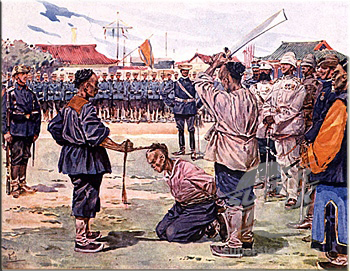
French political cartoon from the late 1890s. A pie represents “Chine” (French for China) and is being divided between UK, Germany, Russia, France and Japan.
In addition, more costly rebellions in terms of human lives and economics followed with the Punti-Hakka Clan Wars, Nien Rebellion, Muslim Rebellion, Panthay Rebellion and the Boxer Rebellion.
In many ways, the rebellions and the unequal treaties the Qing were forced to sign with the imperialist powers are symptomatic of the Qing’s inability to deal with the new challenges of the 19th century.
By the 1860s, the Qing Dynasty had put down the rebellions at enormous cost and loss of life. This undermined the credibility of the Qing regime and, spearheaded by local initiatives by provincial leaders and gentry, contributed to the rise of warlordism in China.
The Qing Dynasty under the Emperor Guangxu proceeded to deal with the problem of modernization through the Self-Strengthening Movement. However, between 1898 and 1908 the Empress Dowager Cixi had the reformist Guangxu imprisoned for being ‘mentally disabled’.
The Empress Dowager, with the help of conservatives, initiated a military coup, effectively removed the young Emperor from power, and overturned most of the more radical reforms. He died one day before the death of the Empress Dowager (some believe Guangxu was poisoned by Cixi). Official corruption, cynicism, and imperial family quarrels made most of the military reforms useless. As a result, the Qing’s “New Armies” were soundly defeated in the Sino-French War (1883-1885) and the Sino-Japanese War (1894-1895).
At the start of the 20th century, the Boxer Rebellion threatened northern China. This was a conservative anti-imperialist movement that sought to return China to old ways.
The Empress Dowager, probably seeking to ensure her continued grip on power, sided with the Boxers when they advanced on Beijing. In response the Eight-Nation Alliance invaded China. Consisting of British, Japanese, Russian, Italian, German, French, US and Austrian troops, the alliance defeated the Boxers and demanded further concessions from the Qing government.
Please follow this link to read more about the Modern History of China.
